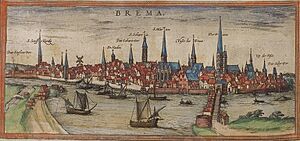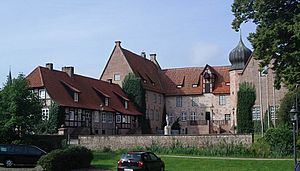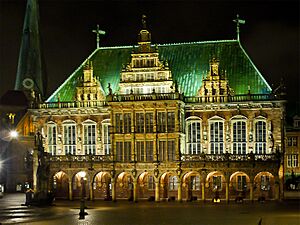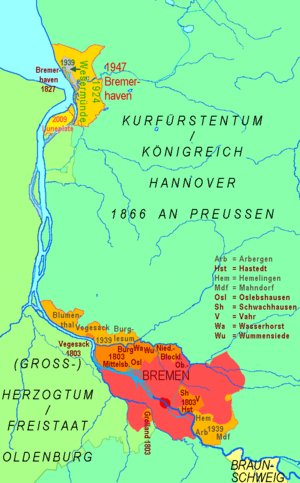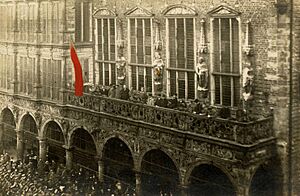History of Bremen (city) facts for kids
For most of its 1,200-year history, Bremen was an independent city within the larger Holy Roman Empire in Germany. In the late Middle Ages, its powerful merchant groups were key members of the Hanseatic League. This league tried to control trade in the North Sea and Baltic Sea. To stay independent, Bremen had to fight against the Prince-Archbishop of Bremen and later against the Swedes. The Swedes had taken control of the areas around Bremen after the Thirty Years' War.
In the late 1800s, Prussia brought Bremen into the German Empire. Thanks to new ports and anchorages at Bremerhaven, Bremen became Germany's main port for people moving to the Americas. It also became a hub for Germany's growing colonial trade. The Norddeutscher Lloyd (NDL) shipping company started in Bremen in 1857 and grew into one of the world's biggest.
In the 1900s, Bremen, known for its liberal and social-democratic ideas, lost its independence under the Hitler regime. After the terrible damage of World War Two, where two-thirds of the city was destroyed, Bremen got its independence back. It became one of the founding states (called Länder) of the German Federal Republic. From the late 1950s, Germany's post-war economic boom (the Wirtschaftswunder) brought many workers to Bremen from Turkey and Southern Europe. Today, about one-third of Bremen's population has non-German roots, including refugees who settled there in the 21st century.
Contents
Early History of Bremen
The marshy and hilly areas near Bremen have been settled since about 12,000 BC. Old burial sites and settlements in Bremen-Mahndorf and Bremen-Osterholz date back to the 7th century AD. Some historians believe that the ancient name Fabiranum or Phabiranon on a map from AD 150 refers to Bremen. However, the map's coordinates suggest a different location.
During the Saxon Wars (772–804), a Saxon leader named Widukind fought against the Franks. The Frankish king Charlemagne eventually won. Thousands of Saxon nobles were killed, and everyone was ordered to become Christian. In 787, Willehad of Bremen became Bremen's first Bishop. In 888, Emperor Arnulf of Carinthia gave Bremen important rights. These rights, confirmed in 965, allowed the city to hold its own markets, make its own coins, and create its own customs laws.
Bremen's first stone walls were built in 1032, and the stone St. Peter's Cathedral followed in 1042. These buildings showed the city's growing wealth from North Sea trade. In the next century, Dutch settlers began to drain the surrounding wetlands and build the dikes that still shape Bremen's landscape today.
In 1186, the Prince-Archbishop Hartwig of Uthlede gave Bremen special rights called the Gelnhausen Privilege. This meant the city had a lot of freedom in making its own laws and collecting taxes. People living in the city were freed from feudal taxes, and even serfs became free if they lived in the city for a year and a day. This privilege was the basis for Bremen's later claim to be a Free Imperial City.
Bremen and the Hanseatic League
In 1260, Bremen joined the Hanseatic League. This was a powerful group of trading towns in northern Europe, mainly focused in Lübeck. The League helped merchants from different regions trade goods like timber, wax, amber, furs, rye, and wheat from the eastern Baltic Sea. For Bremen's strong merchant groups, the League was also important for controlling the salt-fish trade in the North Sea.
Bremen took part in many military actions with the League. These actions aimed to protect and increase the trading group's special rights. In the 1440s, Bremen even hired its own private ships to attack the League's rivals in the North Sea. One famous captain, Grote Gherd ("Great Gerry"), captured thirteen ships from Flanders in one trip!
The trade protected by the League brought both business and new industries to Bremen. Finer wool and linen fabrics, and even silks, were made locally. Other crafts also grew, like etching, wood carving, armor making, and metal engraving. Trade also increased connections with Italy, bringing the Renaissance (a period of new ideas in art and science) to northern Germany early. A lasting example of this time is the Weser Renaissance architectural style, seen in the decorated front of the Bremen Rathaus (City Hall) built in 1612.
The Hanseatic League's power began to fade in the 1500s. This happened as the United Dutch Provinces became strong competitors in trade. Also, powerful kingdoms like Sweden, Denmark-Norway, Brandenburg-Prussia, and England grew stronger, providing better security for trade than the League could.
Fighting the Prince-Archbishop
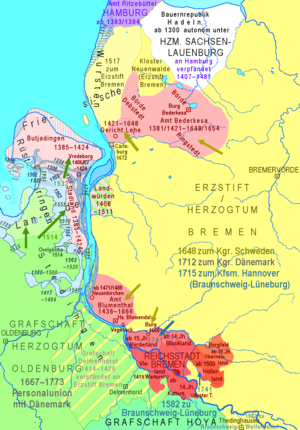
By 1350, Bremen was a city of 20,000 people, and its trade was booming thanks to the Hansekogge (cog ship), a special ship built in Bremen. Despite this, conflicts with the Prince-Archbishop and other powerful lords in the surrounding area continued. In 1365, new taxes were needed to pay a ransom for citizens held hostage by a count. This led to a public uprising in the city, which the city council put down with much bloodshed.
To protect itself from the Prince-Archbishop's attempts to take advantage of its internal problems, the city made its defenses even stronger. A very narrow gate, called the Bishop's Needle, was built. It was only for clergymen, including the Prince-Archbishop. The gate was so narrow that the bishop could not enter the city with his knights. Despite these efforts, the Prince-Archbishop Albert II of Brunswick-Wolfenbüttel managed to capture the city on May 29, 1366. However, within a month, some exiled citizens, with help from the Count of Oldenburg, took the city back and punished those who had helped the Archbishop.
By the late 1360s, Albert was deeply in debt. This put Bremen in a good position. The city was able to buy not only his rights in the city but also many of his surrounding castles and lands.
In 1381, Bremen's troops successfully stopped brigandage (robbery) by other poor lords and knights. The city became their lord, extending its control along the lower Weser River. To show its new power and independence, in 1404, the city replaced its old wooden statue of Roland with a larger stone one. This statue still stands today in front of the Rathaus (City Hall) in the main market square.
In 1421, Bremen reached its largest size. At that time, the Duchy of Saxe-Lauenburg and the Knights of Bederkesa gave their lands on both sides of the lower Weser to Bremen as a guarantee for a loan.
The Reformation in Bremen
Bremen had long been against its Prince-Archbishop and the Church's worldly power. So, the city quickly accepted the Protestant Reformation, which spread across Northern Germany in the late 1520s. In 1532, Bremen's citizens forcefully stopped a Catholic Mass in St. Peter's Cathedral, called the Bremer Dom. They made a pastor hold a Lutheran service instead. The Prince-Archbishop, who still controlled the cathedral, quickly shut its doors. Even so, he could not stop people from converting to the Reformed faith (a type of Protestantism), even in areas he directly controlled.
In 1547, the cathedral leaders, who were mostly Lutheran by then, appointed Albert Hardenberg, a Dutch pastor, as the Cathedral's first Protestant pastor. However, Hardenberg followed the ideas of Zwinglian (another Protestant reformer). After many arguments, the cathedral closed its doors again in 1561, only fully reopening in 1638.
By the 1590s, most of Bremen's citizens and the city council had adopted Calvinism (another Protestant faith). This was different from the cathedral leaders, who remained Lutheran under the Prince-Archbishop. This disagreement between the Calvinist majority and the Lutheran minority (who controlled the Cathedral until 1803) lasted well into the 1800s. The conflict was finally resolved in 1873 when the Calvinist and Lutheran churches in Bremen joined together under the Bremen Protestant Church.
Bremen and the Thirty Years' War
Soon after the Thirty Years' War began, Bremen declared that it would stay neutral. In 1623, it refused to help the Republic of the Seven United Netherlands in its fight for independence against Spain. However, Imperial troops and Catholic forces moved north. The Imperial general, Albrecht von Wallenstein, wanted to break up the Hanseatic League and create new trade monopolies in the Baltic Sea. In 1628, Bremen paid Wallenstein a large sum of money to avoid being attacked. This way, the city managed to avoid being occupied throughout the war.
In 1629, an Imperial order told Bremen to give back properties and rights within the city, including control of the Cathedral, to a Catholic Prince-Archbishop. The city refused, saying it would rather leave the Holy Roman Empire and join the Dutch Republic. The arrival of the Lutheran Swedes, led by Gustavus Adolphus, saved Bremen from the negative results of its defiance. However, once Swedish forces controlled the former church lands around the city (which was confirmed by the Treaty of Westphalia in 1648), Bremen felt a new threat to its independence.
Bremen had asked the Emperor to confirm its imperial immediacy, meaning it was directly under the Emperor and not a local lord. Bremen argued this was implied in the Gelnhausen Privilege of 1186. In 1646, Emperor Ferdinand III agreed, recognizing Bremen as a Free Imperial City.
Swedish Wars and Independence
| Historical population | ||
|---|---|---|
| Year | Pop. | ±% p.a. |
| 1350 | 20,000 | — |
| 1810 | 35,800 | +0.13% |
| 1830 | 43,700 | +1.00% |
| 1850 | 55,100 | +1.17% |
| 1880 | 111,900 | +2.39% |
| 1900 | 161,200 | +1.84% |
| 1925 | 295,000 | +2.45% |
| 1969 | 607,185 | +1.65% |
| 1995 | 549,357 | −0.38% |
| 1998 | 550,000 | +0.04% |
| 2001 | 540,950 | −0.55% |
| 2005 | 545,983 | +0.23% |
| 2006 | 546,900 | +0.17% |
| 2009 | 547,685 | +0.05% |
| 2012 | 548,319 | +0.04% |
| 2014 | 548,547 | +0.02% |
Sweden did not accept that its new territory, Bremen-Verden, did not include Bremen itself. In 1653, Swedish troops captured Bremerlehe. This made Bremen ask Emperor Ferdinand III for help again. In February 1654, the Emperor gave Bremen a seat and a vote in the Imperial Diet (a kind of parliament) for the first time. He also demanded that Christina of Sweden return Bremerlehe and pay Bremen back. Despite these orders, more fighting happened. Bremen was eventually forced to pay taxes to Swedish Bremen-Verden and give up some land.
In 1664, after Bremen was again given a seat in the Imperial Diet, the Swedes, led by Carl Gustaf Wrangel, attacked the city. In response, other powerful groups, including Brandenburg-Prussia, Denmark, and the Netherlands, joined together to defend Bremen. This led to the Treaty of Habenhausen in 1666, which ended any further Swedish attempts to take the city.
In 1712, during the Great Northern War (1700–1721) against Swedish power in the Baltic Sea, the area of Bremen-Verden was taken over by Frederick IV of Denmark. In 1715, he gave the territory to a new ally, George I, who was also the Elector of Hanover and King of Great Britain. Surrounded by Hanover, which was linked to Britain, Bremen was largely safe from the wars of the 1700s.
Bremen in the 19th Century
As part of his plan to stop British trade in Europe, Napoleon took over Bremen in 1811. He made it the capital of a French region. In 1813, after their defeat at the Battle of Leipzig, the French left. Johann Smidt, Bremen's representative at the Congress of Vienna, successfully argued for Bremen, Hamburg, and Lübeck to remain independent. Instead of being absorbed into nearby kingdoms, these three Hanseatic cities got their old independence back as republics within the new German Confederation.
After Prussia defeated Austria in 1866 and took over Hanover, Bremen joined Berlin in the North German Confederation. When Germany won against France in 1871, this Confederation grew to form the German Empire.
Meanwhile, Bremen was growing as an industrial port. The first German steamship was built in 1817. However, the port, which was 37 kilometers upriver from the sea, faced problems because the Weser River kept silting up. In 1827, Bremen's Mayor Smidt managed to buy land from Hanover at the mouth of the Weser, creating the new port of Bremerhaven.
With new railroad connections, this new seaport helped Bremen stay ahead of Hamburg as Germany's main port for people moving to the Americas. These migrants came not only from southern and eastern Germany but also from Central and Eastern Europe starting in the 1880s. The port also allowed Bremen to be Germany's center for colonial trade, importing and processing coffee, tobacco, cotton, and rice. This trade grew as Germany started to get its own colonies in Africa and the South Seas after 1884.
The growth of colonies and a plan to build more naval ships were strongly supported by Bremen's merchants. Bremen is still known as "Germany's coffee capital" today, with famous brands like Jacobs and HAG. Another reminder of this colonial past is the Reichskolonial-Ehrenmal, a ten-meter brick elephant monument. For many years, it symbolized German colonial dreams. But recently, it has been changed into a "Bremen anti-colonial monument," with a memorial to the victims of the German genocide in present-day Namibia placed next to it.
The combination of many people moving across the Atlantic and colonial trade led to the growth of major international shipping companies in Bremen. The biggest of these was Norddeutscher Lloyd (NDL), founded in 1857. Today, it is part of Hapag-Lloyd.
Bremen in the 20th Century
A City of Liberal and Left-Wing Ideas
As an international port and industrial center, Bremen had a strong history of liberal and left-wing politics. In the last elections for the Imperial Reichstag in January 1912, the Social Democrats (SPD) won over half the votes (53.4%). Left Liberals got another 41.4%, and only 5.1% went to the Conservatives.
After Germany lost World War I, and facing chaos from naval and army rebellions and hardships from a long British blockade, Bremen was briefly governed by a revolutionary council of workers and soldiers.
After two months, on January 10, 1919, the Independent Social Democrats on the council, along with the new communist party, declared Bremen a Soviet Republic. This was against the SPD-led government in Berlin. Within three weeks, the republic was crushed by right-wing military groups called Freikorps. Despite this, left-wing parties remained strong in Bremen.
In the last mostly free election of the Weimar Republic in November 1932, the Social Democrats won 31.2% of the votes in Bremen. The Communists (KPD) received 16.8%. The Nazis got 20.8%, which was much lower than their national average.
Under the Hitler Regime
After the Reichstag Fire Decree on February 27, 1933, the new Hitler regime began arresting or forcing members of the Communist Party and the Social Democratic Party into hiding. Violence broke out in Bremen the day before the Reichstag election on March 5, 1933, and 40 people were arrested. Even in this election, the Nazis only got 32.7% of the votes in Bremen, far below their national average of 44%.
The next morning, a large crowd led by Nazi brownshirts gathered in the market square. They demanded the Senate (city government) resign and hung swastika flags on the city hall. The police chief refused to get involved. A Nazi group entered the city hall and demanded that the police be controlled by the Nazi Party. The Senate did not agree to these demands, but they did agree to raise the old Imperial flag. As a result, the three Social Democratic members of the Senate resigned. However, since the Senate rejected other demands, the Reich Interior Minister intervened and appointed a Nazi official to control the Bremen police. Soon after, the remaining Senate members agreed to disband, leaving Bremen under Nazi control.
On March 31, 1933, the Nazi government passed a law that reorganized city governments based on the recent Reichstag election. When Communist Party members were excluded, the Nazis and their allies gained a majority. However, on October 14, 1933, the Bremen city parliament (Bürgerschaft) was dissolved, along with all other state parliaments. On January 30, 1934, another law abolished all state parliaments. So, the Bremen Bürgerschaft, which had existed since 1849, was completely removed. Bremen remained under the direct authority of the Nazi leader for the region, who was based in Oldenburg. Bremen technically remained a German state but was effectively just an administrative unit of the Nazi regime.
At the start of 1933, 1,438 people were registered as members of the Jewish community in Bremen. About 930 of them managed to leave Germany by 1941. Those who remained faced the same terrible fate as Jews elsewhere in Germany: they were sent away and killed in concentration camps in occupied Poland. The Bremen-Farge concentration camp, a sub-camp of the Neuengamme camp, was set up in late 1943. Prisoners there were forced to work as slave labour at the U-boat Bunker Valentin.
In the Nazi war economy, Bremen became a center for building naval ships, especially submarines, and also for aircraft production. Focke-Wulf, an aviation company, was founded in Bremen in 1923. Borgward, a car manufacturer, also became a military contractor. War production used forced foreign labor on a very large scale.
Several villages became part of the city of Bremen in 1939.
Allied bombing during World War II destroyed most of the historic Hanseatic city, as well as 60% of its homes. The British 3rd Infantry Division captured Bremen in late April 1945. The British then handed Bremen over to the Americans. The city became an American-controlled port for supplying the US zones in west Berlin and southern Germany.
Rebuilding After the War
On August 1, 1945, the US military government appointed Wilhelm Kaisen (SPD) as mayor of Bremen. He had been a senator before 1933. Kaisen stayed mayor through several elections until he retired in 1965. With initial support from Communists and Liberals, Kaisen worked to bring back the democratic system that existed before Hitler. To prevent Bremen from being absorbed into the new state of Lower Saxony, he successfully argued for Bremen's traditional independence to the United States in 1946.
On November 20, 1945, a group of Polish displaced persons (DPs) from a camp attacked a house where a family of 13 people were staying. After the residents gave up their food and valuables, they were taken to the basement and shot. Wilhelm Hamelmann, 43, was the only survivor because he pretended to be dead. He later gained attention for publicly forgiving the attackers, even though they killed his wife and children.
Bremen's famous Renaissance-fronted Gothic Town Hall (Rathaus), the Roland statue (1404) (a symbol of the city's independence), and the 11th-century cathedral (Bremer Dom) survived the Allied bombing. Limited efforts were made to restore other damaged old city buildings. The main focus was on building new homes, as the population had grown and many German refugees from eastern territories had arrived. Restoring industrial production and transport were also top priorities in this early rebuilding phase.
Between the 1950s and 1960s, Bremen's economy boomed, just like the rest of West Germany's Wirtschaftswunder (economic miracle). This led to the growth and permanent settlement of many migrant workers, mostly from Turkey and Southern Europe.
After the Economic Boom
Some of Bremen's heavy industries struggled to recover from the oil-price-shock recession of the early 1970s and from growing industrial output in East Asia. Specialist shipyards and suppliers still exist, but Bremen's two major shipbuilders, AG Weser and Bremer Vulcan, closed in 1983 and 1997. More jobs were lost due to changes and increased use of machines in port activities and other industries. Workers with fewer skills found it very hard to find new jobs, and unemployment in Bremen remained high for a while.
At a time when these economic changes forced the city government to spend more on social services, people moving to the suburbs reduced Bremen's population and tax money. Bringing in surrounding suburban towns was not an option for Bremen, as they belonged to the state of Lower Saxony.
After the 1991 elections, the SPD, while still the strongest party, had to form coalitions and make political compromises. The first coalition was with the smaller Free Democratic Party (FDP) and the Green Party. City leaders realized that public money could slow down the decline of less competitive industries, but it couldn't stop or reverse it completely. Cutting subsidies was especially hard for the Social Democrats, given their strong ties to manual workers and trade unions.
Eventually, with financial help from the European Union, everyone agreed on the need to support advanced technology industries. These included aerospace, car production, shipping, and logistics services. They also decided to develop education and business parks for new science-based and digital companies. The University of Bremen, founded in 1971, plays a key role in this. It is one of 11 "Elite universities" in Germany and teaches about 23,500 students from 126 countries. More money was invested in making the city center lively again, but a culture-focused plan around entertainment and tourism was not very successful. Some experts said Bremen's service sector was not developed enough because it lacked major company headquarters.
At the start of the new century, unemployment in Bremen was 14%. This rate was only matched in Germany by the "new states" in former East Germany.
A New Immigrant City
As an international port and industrial center, Bremen has always attracted people from other countries. In recent decades, changes in the economy and international events have led to a rapidly changing mix of people.
As of 2020, almost one-third of the city's population had non-German roots. People of Turkish origin (first, second, and third generation) are still the largest non-German group (there are 23,000 Turkish-born residents). However, due to refugee resettlement since 2015, Syrians (18,000) are now close behind. There are also many people from Central and Eastern Europe, especially from Poland, Bulgaria, and Romania.
The SPD's Long-Standing Influence
Except for a brief period from 1918-1922 when they split, the Social Democrats have been the leading party in every free election in Bremen since 1912. They have formed every city government since 1945, either alone (1971-1991) or in a coalition. Since 2007, they have governed with the Greens. In 2019, the Left (die Linke) joined this coalition, after the SPD won its lowest share of the popular vote (24.9%) since the war. There was a recovery in the 2021 Federal elections, with Social Democrats in Bremen taking one-third of the vote.
See also
 In Spanish: Historia de Bremen para niños
In Spanish: Historia de Bremen para niños
- Timeline of Bremen


